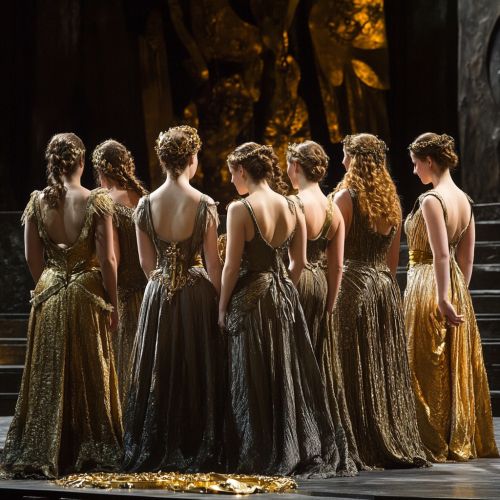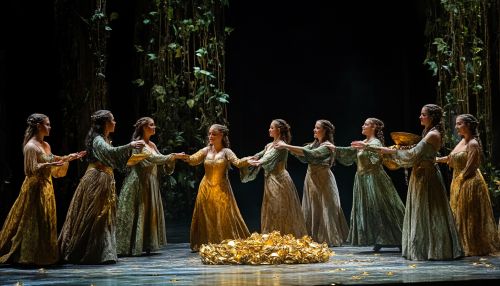Der Ring des Nibelungen: Difference between revisions
(Created page with "== Overview == '''Der Ring des Nibelungen''' (The Ring of the Nibelung) is a cycle of four epic music dramas by the German composer Richard Wagner. The works are based loosely on characters from the Norse sagas and the Nibelungenlied. The cycle is often referred to as the Ring Cycle, Wagner's Ring, or simply The Ring. == Composition and Structure == The Ring Cycle consists of four operas: ''Das Rheingold'' (The Rhinegold),...") |
No edit summary |
||
| Line 14: | Line 14: | ||
''Das Rheingold'' serves as the prologue to the Ring Cycle. It introduces the key characters and sets the stage for the ensuing drama. The opera opens with the dwarf Alberich stealing the Rhinegold from the Rhinemaidens and forging it into a ring that grants him immense power. The gods, led by Wotan, also covet the ring, leading to a series of betrayals and conflicts. | ''Das Rheingold'' serves as the prologue to the Ring Cycle. It introduces the key characters and sets the stage for the ensuing drama. The opera opens with the dwarf Alberich stealing the Rhinegold from the Rhinemaidens and forging it into a ring that grants him immense power. The gods, led by Wotan, also covet the ring, leading to a series of betrayals and conflicts. | ||
[[Image:Detail-97921.jpg|thumb|center|Scene from Das Rheingold, showing the Rhinemaidens and the Rhinegold.|class=only_on_mobile]] | |||
[[Image:Detail-97922.jpg|thumb|center|Scene from Das Rheingold, showing the Rhinemaidens and the Rhinegold.|class=only_on_desktop]] | |||
=== Die Walküre === | === Die Walküre === | ||
Latest revision as of 01:46, 11 September 2024
Overview
Der Ring des Nibelungen (The Ring of the Nibelung) is a cycle of four epic music dramas by the German composer Richard Wagner. The works are based loosely on characters from the Norse sagas and the Nibelungenlied. The cycle is often referred to as the Ring Cycle, Wagner's Ring, or simply The Ring.
Composition and Structure
The Ring Cycle consists of four operas: Das Rheingold (The Rhinegold), Die Walküre (The Valkyrie), Siegfried, and Götterdämmerung (Twilight of the Gods). Wagner wrote the libretto and music over the course of about twenty-six years, from 1848 to 1874. The first performance as a cycle took place in 1876 at the Bayreuth Festspielhaus, a theater specifically designed for the presentation of Wagner's works.
Themes and Motifs
The Ring Cycle explores a variety of complex themes, including power, greed, love, betrayal, and redemption. Central to the narrative is the Ring of the Nibelung, a powerful artifact that grants its bearer dominion over the world but brings with it a curse of doom and destruction.
Wagner employs a system of leitmotifs—recurring musical themes associated with particular characters, objects, or ideas. These leitmotifs serve to unify the sprawling narrative and provide a rich tapestry of musical and dramatic connections.
Synopsis of the Operas
Das Rheingold
Das Rheingold serves as the prologue to the Ring Cycle. It introduces the key characters and sets the stage for the ensuing drama. The opera opens with the dwarf Alberich stealing the Rhinegold from the Rhinemaidens and forging it into a ring that grants him immense power. The gods, led by Wotan, also covet the ring, leading to a series of betrayals and conflicts.


Die Walküre
Die Walküre focuses on the human characters and their interactions with the gods. It tells the story of the twins Siegmund and Sieglinde, who fall in love despite their forbidden relationship. Their union produces Siegfried, the hero of the cycle. The opera also explores the complex relationship between Wotan and his daughter Brünnhilde, a Valkyrie who defies her father to protect Siegmund.
Siegfried
Siegfried follows the titular hero as he grows up unaware of his true heritage. Raised by the dwarf Mime, Siegfried eventually learns of his destiny and sets out to reclaim the ring. He slays the dragon Fafner, who guards the treasure, and awakens Brünnhilde from her enchanted sleep.
Götterdämmerung
Götterdämmerung brings the cycle to a dramatic conclusion. Siegfried is betrayed and killed, and Brünnhilde sacrifices herself to cleanse the world of the ring's curse. The gods meet their end in a cataclysmic fire, symbolizing the twilight of the gods and the dawn of a new era.
Musical Innovations
Wagner's Ring Cycle is renowned for its innovative use of orchestration and harmony. He expanded the traditional orchestra to include a wide array of instruments, such as the Wagner tuba, to achieve a richer and more varied sound. His use of chromaticism and unresolved dissonances pushed the boundaries of tonality, paving the way for future developments in Western classical music.
Staging and Performance History
The Ring Cycle is one of the most ambitious and demanding works in the operatic repertoire. Its full performance takes approximately 15 hours, usually spread over four evenings. The first complete performance took place at the Bayreuth Festspielhaus in 1876, a theater specifically designed by Wagner for the presentation of his works.
Since then, the Ring Cycle has been staged by numerous opera companies worldwide, each bringing its own interpretation to the complex narrative and rich musical tapestry. Notable productions include those by Patrice Chéreau at Bayreuth in 1976 and Robert Lepage at the Metropolitan Opera in 2010.
Cultural Impact
The Ring Cycle has had a profound influence on both music and popular culture. Its themes and motifs have been referenced in various forms of media, from literature and film to video games and comic books. The cycle's exploration of power, corruption, and redemption continues to resonate with contemporary audiences.
